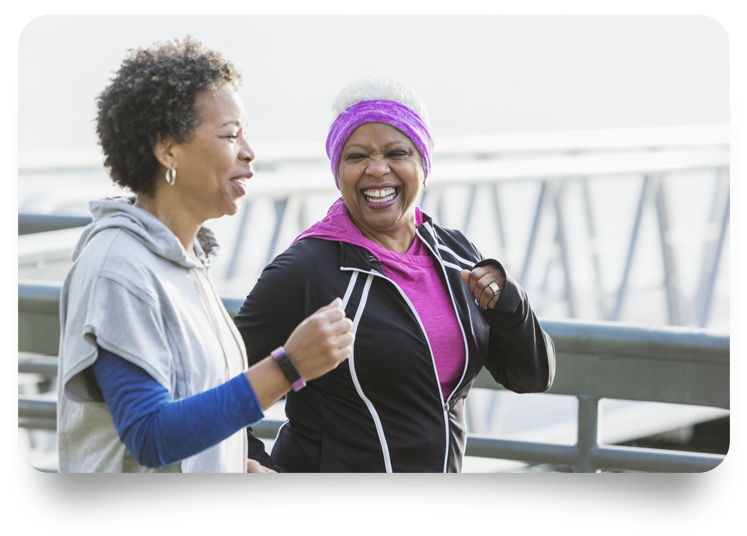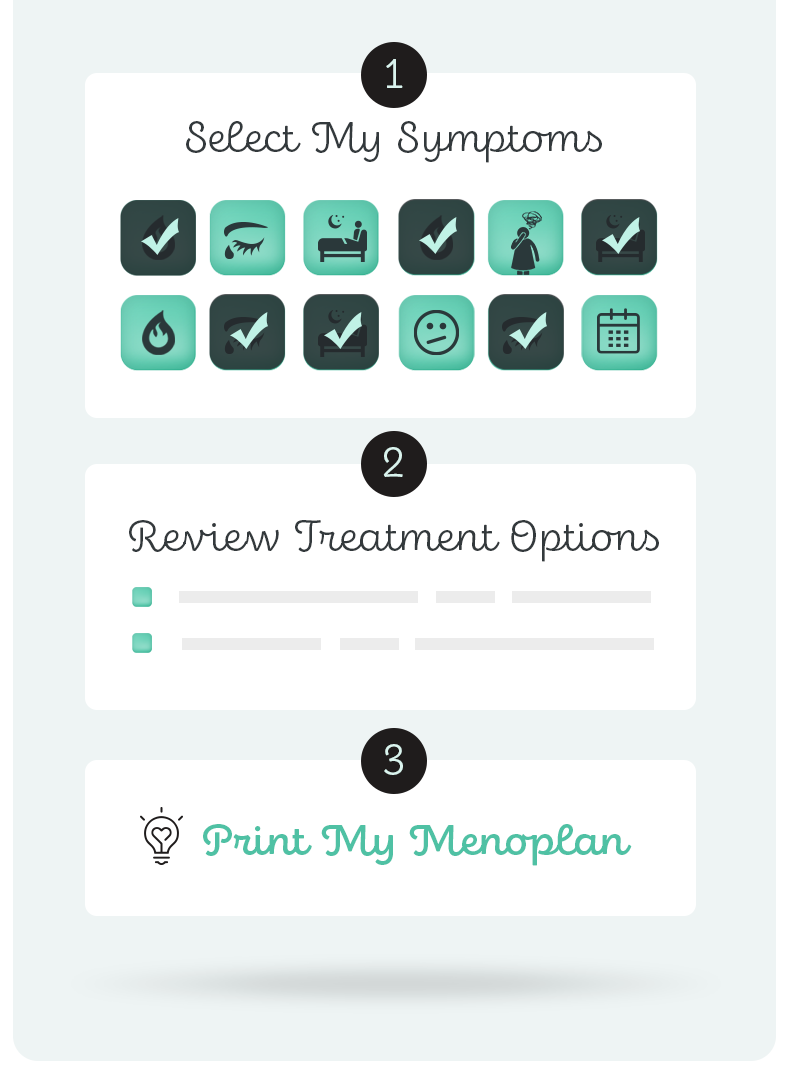Treatments
WHAT IS IT?
Exercise is any type of physical activity. It is important for our health to avoid inactivity. People who exercise are less likely to get chronic diseases than people who don’t. Exercise can also help people with a chronic disease improve their health and prevent new diseases.
Aerobic activity is good for your heart, brain, and lungs. It can be high intensity, or more moderate. The recommended time you spend per week depends on intensity of the activity.
Moderate aerobic exercise increases our heart rate, makes us breathe harder and makes us sweat. This includes activities like walking quickly, bicycling, and swimming at a comfortable pace, or heavy housework. Health experts recommend 150-300 minutes per week of moderate intensity aerobic exercise. Health benefits are greater as you get closer to 300 minutes per week.
High intensity exercise is when your heart rate is very high and you would have trouble having a conversation. Examples are running or using an elliptical machine or bike in a vigorous way. If your exercise is high intensity, health experts recommend 75-150 minutes per week.
It’s best if you spread aerobic exercise out during the week.
Exercises that are weight-bearing – like walking or running – are also good for your bones and help prevent bone-thinning and osteoporosis. Swimming and biking are not weight bearing.
It’s also important to do muscle-strengthening exercises, such as lifting weights, Pilates, and some forms of yoga. Experts recommend working all the major muscle groups at least 2 times a week.
Stretching helps your body remain flexible. It is good to stretch after aerobics and muscle strengthening.
Finally, it is important to maintain muscles related to balance to prevent falls. As we age, falling can become more of a problem, and affect our ability to get around by ourselves. Yoga, tai chi, chi gong, and dance can help with balance.
If you have a chronic health condition or disabilities and are able to exercise, you can talk to your health care provider about safe ways to exercise. The national guidelines for the amount and types of exercise are the same as for other women.
OUR BOTTOM LINE: DOES IT HELP?
YES. Since physical activity has many health benefits and few risks, we strongly recommend it for all women who can exercise. Physical activity can improve your mood, including depression and anxiety, and help with sleep.
NO. However, chances are exercise will not reduce hot flashes and night sweats. If you are bothered by hot flashes or night sweats, you should also explore other solutions.

MOOD, ANXIETY & DEPRESSION
Exercise can help your mood and may decrease anxiety or depression.

SLEEP PROBLEMS & INSOMNIA
Exercise helps you sleep better. Most people sleep better if they stop exercise at least an hour before bedtime.

ACHES AND PAINS
Exercise may help with chronic aches and pains. The type of exercise is best targeted to the type and cause of the pain.

WEIGHT GAIN
For the general population, exercise and diet help with weight loss, although it can be hard to maintain the weight loss over time. Exercise can help prevent regaining weight after weight loss. The research has most often been done with adult women, not specifically women in menopause. More research is needed to understand the role of exercise at each stage of menopause.

BRAIN FOG
The lack of physical activity is related to brain fog during menopause, so it is plausible that physical activity may help or prevent brain fog from getting worse. Physical activity can also decrease stress – another factor in brain fog. In addition, studies of older women, post-menopause, show that physical activity helps memory.

HOT FLASHES AND NIGHT SWEATS
Exercise is not a solution for hot flashes or night sweats and won’t make them better or worse. Exercising more will not decrease the severity of hot flashes or night sweats. Exercise will not change how much hot flashes and night sweats interfere with daily activities. Some women do have hot flashes right after they exercise, but exercise does not increase the total number of hot flashes that women have.
POTENTIAL RISKS & SIDE EFFECTS
Overall, exercise is not risky. Pick activities to match your current fitness level, use the right gear and sports equipment, and do it in a safe place.
It is possible to pull or strain a muscle.
You may also have muscle aches for a day or two after exercising, when muscles get a good workout. Some people feel good about those aches because they know they are strengthening those muscles. You can massage the area, stretch, and smile to yourself on a workout well done.
The most serious risk of exercise is a heart attack, but this is rare. The risk of a heart attack is higher during very intense exercise. The good new, though, is that people who regularly exercise are at lower risk of a heart attack than people who do not exercise regularly.
QUALITY OF LIFE EXPECTATIONS
A large trial of exercise and menopause symptoms found exercise did not improve menopause quality of life overall.
IF I WANT TO TRY THIS TREATMENT WHAT ARE MY NEXT STEPS?
Healthy people who want to start an exercise program may do so safely and without consulting their health care provider. If you are not currently exercising, it is best “start low and go slow”. That means start with lower intensity activities for a short time each day, and gradually increase the intensity and amount of time each week. This gives your body a chance to get used to the change.
To lessen your chances of injury, try to pick low impact activities. Examples are walking, cycling, dancing, or swimming. This is especially important if you do not have a lot of experience with exercise or have existing muscle or bone problems.
If you have existing heart disease, diabetes, or other chronic conditions and are not currently active, it is a good idea to talk to your doctor or physical therapist about which activities would be best for you.
One of the easiest ways start exercising is to begin a walking program. Some people use a tracker on their phone, a wearable device like a Fitbit, or a pedometer to count their steps, track time spent exercising daily and weekly, and chart their progress over time.
Think about your schedule so you can make exercise a habit. Some women find it easier to stick to their exercise plan (and harder to cancel) if they do at least some activities with a friend.
If you have limited time (and who doesn’t!), know that grabbing the time when you can also works. Research has found that three 10-minute bouts of moderate physical activity are as good as one 30-minute bout. For example, some people park car or get off a bus or train farther from work so they can get a 10-minute walk each way. Some people take a walk during lunch. Some people take stairs instead of the elevator to get their heart rate up during the day. Short bouts of physical activity can also help clear your head.
You can also check out your community’s recreation department and local fitness clubs. They usually have certified exercise trainers who can help you create an exercise program that works best for you. Many have classes you can explore to find the type of activities you like best.
It also can help to track how exercise makes you feel. As they get used to it, many women feel more energetic, and better about their bodies.
Check out the US Physical Activity Guidelines for Americans.
As summarized in the U.S. Physical Activity Guidelines Advisory Committee report (2018), very strong scientific evidence exists to show that physically active people of all ages have higher health-related fitness and lower risk of developing a wide range of chronic diseases than inactive people.
There is no evidence that menopause-related vasomotor symptoms can be alleviated with exercise. To date, studies have tested aerobic exercise, rather than strength-training or stretching. There have been a several systematic reviews.
A Cochrane systematic review (Daley, 2014) of five studies considered the evidence inconclusive and generally of low quality. There was no difference was observed in frequency or intensity of vasomotor symptoms between either exercise training and no exercise training or exercise training and yoga. Only the MsFLASH trial (Sternfeld) was rated as low risk for bias, and it found no decrease in hot flashes or night sweats, and a secondary analysis found no improvement in overall menopause related quality of life. (Diem)
A subsequent review by the Veteran’s Administration (2016) included the studies in Daley (2014) plus two additional RCTs published after 2014. It, too, concluded that there was no evidence that structured aerobic exercise had any effect on frequency or severity of VMS, relative to either no exercise or yoga.
Exercise was not recommended as a treatment for VMS in a 2015 position statement from the North American Menopause Society.
Although most of this evidence base is built on findings in white, generally healthy women, there is no suggestion that exercise would be efficacious for VMS in specific subgroups of the population defined either by demographic characteristics of health status.
Resistance (or muscle-strengthening) exercises, such as weight training and Pilates, has not, to date, been tested as a treatment for vasomotor symptoms. A 2016 publication described a resistance training randomized controlled trial protocol for hot flashes in postmenopausal women (Berin, 2016). Stretching, or flexibility exercises, on the other hand, have been used in treatment trials, generally as a control condition in comparison with aerobic exercise training.
2018 Physical Activity Guidelines Advisory Committee. 2018 Physical Activity Guidelines Advisory Committee Scientific Report. Washington, DC: U.S. Department of Health and Human Services, 2018.
Berin E, Hammar ML, Lindblom H, Lindh-Åstrand L, Spetz Holm AC. Resistance training for hot flushes in postmenopausal women: Randomized controlled trial protocol. Maturitas. 2016 Mar;85:96-103. doi: 10.1016/j.maturitas.2015.12.015. Epub 2016 Jan 3.
Goldstein KM, Coeytaux RR, Williams Jr JW, Shepherd-Banigan M, Goode AP, McDuffie JR, Befus D, Adam S, Masilamani V, Van Noord MG. Nonpharmacologic Treatments for Menopause-Associated Vasomotor Symptoms. VA ESP Project #09-009; 2016.
Position statement: Nonhormonal management of menopause-associated vasomotor symptoms: 2015 position statement of The North American
Menopause Society, Menopause: The Journal of The North American Menopause Society. Vol. 22, No. 11, pp. 000-000 DOI: 10.1097/GME.0000000000000546, 2015 by The North American Menopause Society
Daley A, Stokes-Lampard H, Thomas A, MacArthur C., Exercise for vasomotor menopausal symptoms. Cochrane Database Syst Rev. 2014 Nov 28;(11):CD006108. doi: 10.1002/14651858.CD006108.pub4. Review. PMID: 25431132
Geneen LJ, Moore RA, Clarke C, Martin D, Colvin LA, Smith BH. Physical activity and exercise for chronic pain in adults: an overview of Cochrane Reviews. Cochrane Database Syst Rev. 2017;4(4):CD011279. Published 2017 Apr 24. doi:10.1002/14651858.CD011279.pub3
Schuch FB, Vancampfort D, Rosenbaum S, et al. Exercise for depression in older adults: a meta-analysis of randomized controlled trials adjusting for publication bias. Braz J Psychiatry. 2016;38(3):247‐254. doi:10.1590/1516-4446-2016-1915
Guthrie KA, LaCroix AZ, Ensrud KE, et al. Pooled Analysis of Six Pharmacologic and Nonpharmacologic Interventions for Vasomotor Symptoms. Obstet Gynecol. 2015;126(2):413‐422. doi:10.1097/AOG.0000000000000927
Reed SD, LaCroix AZ, Anderson GL, et al. Lights on MsFLASH: a review of contributions. Menopause. 2020;27(4):473‐484. doi:10.1097/GME.0000000000001461
Guthrie KA, Larson JC, Ensrud KE, et al. Effects of Pharmacologic and Nonpharmacologic Interventions on Insomnia Symptoms and Self-reported Sleep Quality in Women With Hot Flashes: A Pooled Analysis of Individual Participant Data From Four MsFLASH Trials. Sleep. 2018;41(1):zsx190. doi:10.1093/sleep/zsx190
Sternfeld B, Guthrie KA, Ensrud KE, et al. Efficacy of exercise for menopausal symptoms: a randomized controlled trial. Menopause. 2014;21(4):330‐338. doi:10.1097/GME.0b013e31829e4089
Last reviewed February 15, 2021



